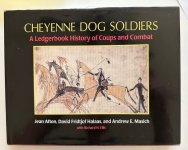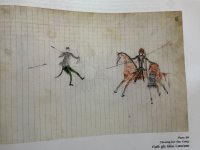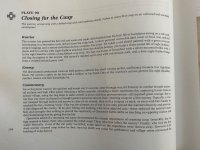- Joined
- Feb 2, 2011
- Messages
- 2,093
JJDESIGNS NEWS UPDATE 1st JANUARY 2024
THUNDER ON THE PLAINS
THE BLACK HILL WARS 1876-1877
THE BATTLE WHERE THE GIRL SAVED HER BROTHER, 17[SUP]th[/SUP] JUNE 1876
The Cheyenne named, the more commonly known The Battle Of The Rosebud, The Battle Where The Girl Saved Her Brother. This was because of an incident during the fight involving the Cheyenne woman Buffalo Calf Road Woman, and her brother Chief Comes In Sight.

The battle took place on June 17[SUP]th[/SUP] 1876 in the Montana territory , between the United States Army and its Crow and Shoshoni allies, against a force consisting mostly of Sioux and Cheyenne Indians.
Led by Crazy Horse, the Sioux and Cheyenne managed to halt the offensive of General George Crook, untill August.

Under the leadership of Crazy Horse, the Cheyenne and Lakota Sioux had been skirmishing with the United States forces. Many warriors had charged, and one man who had the best horse was in the lead. This was Chief Comes In Sight. Before he could reach the soldiers, his horse was wounded and its hind leg broken. The Cheyenne retreated leaving Chief Comes In Sight on foot in the battlefield. SAs he was walking away with all the soldiers shooting at him, Buffalo Calf Road Woman rode out onto the battlefield at full speed and grabbed up her brother, carrying him to safety. Her courageous rescue caused the Cheyenne to rally, and they defeated General George Crook and his forces.
In honour of this brave deed, the Cheyenne named the battle, “The Battle Where The Girl Saved Her Brother.”
The battle which ensued would last for six hours and consisted of disconnected actions and charges and counter-charges by Crook and Crazy Horse, the two forces spread out over a fluid front three miles wide. The Lakota Sioux and Cheyenne were divided into several groups as were the soldiers as the battle progressed. The soldiers could fend off assaults by the Indians and force them to retreat but could not catch and destroy them
The soldiers were impressed with the swarming Indians. "They were the best cavalry soldiers on earth. In charging up toward us they exposed little of their person, hanging on with one arm around the neck and one leg over the horse, firing and lancing from underneath the horses' necks, so that there was no part of the Indian at which we could aim."
By the standards of the usual hit-and-run raids of the Plains Indians, the Battle of the Rosebud was a long and bloody engagement. The Lakota and Cheyenne fought with persistence and demonstrated a willingness to accept casualties rather than break off the encounter. The delaying action by Crook's Indian allies during the early stages of the battle saved his command from a devastating surprise attack. The intervention of the Crow and Shoshoni scouts throughout the battle was crucial to averting disaster for Crook.

Please note these 3 sets will be available in February, March and April.
Crook claimed victory by virtue of occupying the battlefield at the end of the day, but his actions belie his claim. Concerned for his wounded and short on supplies, Crook retraced his steps to his camp on Goose Creek, near Sheridan, Wyoming, and remained there immobile for seven weeks awaiting reinforcements. He would play no role in the Battle Of Little Big Horn, eight days later. Crook's Crow and Shoshoni allies left the army for their homes shortly after the battle. The Lakota and Cheyenne returned to the battlefield after Crook's departure and piled up rocks at the location of key events in the battle. Some of the rock piles they built are still there
CHEYENNE DOG SOLDIERS
Warrior Societies were an important aspect of the Plains life, which divided a tribe’s fighting men into distinct units which provided their members with a social club, and an organization in which they could progress through ranks of officership to bring great prestige.
The Dog Men Society, was the largest society among the Cheyenne.
It was made up of males fifteen years and older, and is believed to have contained at least half the men of the entire Cheyenne tribe.
The four bravest Dog Men were chosen to defend the society and the tribe from the raids of the enemy in a particular way for year’s long term.
Each of these chosen men wore a sash of tanned skin eight to ten feet long, which were called “dog strings” or “Dog ropes”.
Whenever a battle was going badly for the Cheyennes, those who had been selected to wear the dog ropes for that year drove their lance into the ground through the end of the sash.They remained attached there, to fight desperately to cover the retreat of all the other warriors. It was expected they would die rather than pull the lance up and retreat.

Among the Cheyenne it was accepted that if a comrade sharply ordered them away, as if they were speaking to a dog, they were free to retreat with the others.

At the end of the year’s term, the sash wearers still surviving gladly relinquished the emblems to four other members newly chosen for the position, and if one had been killed and the dog string lost, his widow prepared a new one for his successor.
All the warriors of the Dog Society dressed alike. The usual style of headdress consisted of a cap with a narrow beaded band along the front edge.
The crown was entirely covered with the tail feathers of the golden eagle, raven, the hawk or the crow. They were fastened in a way which made them stand erect all over the headdress.
A whistle made from the wing bone of an eagle was suspended by a string from the neck of each warrior.
The first of the Dog Soldiers will be available in May.
Best wishes, and Happy New Year!
john jenkins
THUNDER ON THE PLAINS
THE BLACK HILL WARS 1876-1877
THE BATTLE WHERE THE GIRL SAVED HER BROTHER, 17[SUP]th[/SUP] JUNE 1876
The Cheyenne named, the more commonly known The Battle Of The Rosebud, The Battle Where The Girl Saved Her Brother. This was because of an incident during the fight involving the Cheyenne woman Buffalo Calf Road Woman, and her brother Chief Comes In Sight.

The battle took place on June 17[SUP]th[/SUP] 1876 in the Montana territory , between the United States Army and its Crow and Shoshoni allies, against a force consisting mostly of Sioux and Cheyenne Indians.
Led by Crazy Horse, the Sioux and Cheyenne managed to halt the offensive of General George Crook, untill August.

Under the leadership of Crazy Horse, the Cheyenne and Lakota Sioux had been skirmishing with the United States forces. Many warriors had charged, and one man who had the best horse was in the lead. This was Chief Comes In Sight. Before he could reach the soldiers, his horse was wounded and its hind leg broken. The Cheyenne retreated leaving Chief Comes In Sight on foot in the battlefield. SAs he was walking away with all the soldiers shooting at him, Buffalo Calf Road Woman rode out onto the battlefield at full speed and grabbed up her brother, carrying him to safety. Her courageous rescue caused the Cheyenne to rally, and they defeated General George Crook and his forces.
In honour of this brave deed, the Cheyenne named the battle, “The Battle Where The Girl Saved Her Brother.”
The battle which ensued would last for six hours and consisted of disconnected actions and charges and counter-charges by Crook and Crazy Horse, the two forces spread out over a fluid front three miles wide. The Lakota Sioux and Cheyenne were divided into several groups as were the soldiers as the battle progressed. The soldiers could fend off assaults by the Indians and force them to retreat but could not catch and destroy them
The soldiers were impressed with the swarming Indians. "They were the best cavalry soldiers on earth. In charging up toward us they exposed little of their person, hanging on with one arm around the neck and one leg over the horse, firing and lancing from underneath the horses' necks, so that there was no part of the Indian at which we could aim."
By the standards of the usual hit-and-run raids of the Plains Indians, the Battle of the Rosebud was a long and bloody engagement. The Lakota and Cheyenne fought with persistence and demonstrated a willingness to accept casualties rather than break off the encounter. The delaying action by Crook's Indian allies during the early stages of the battle saved his command from a devastating surprise attack. The intervention of the Crow and Shoshoni scouts throughout the battle was crucial to averting disaster for Crook.

Please note these 3 sets will be available in February, March and April.
Crook claimed victory by virtue of occupying the battlefield at the end of the day, but his actions belie his claim. Concerned for his wounded and short on supplies, Crook retraced his steps to his camp on Goose Creek, near Sheridan, Wyoming, and remained there immobile for seven weeks awaiting reinforcements. He would play no role in the Battle Of Little Big Horn, eight days later. Crook's Crow and Shoshoni allies left the army for their homes shortly after the battle. The Lakota and Cheyenne returned to the battlefield after Crook's departure and piled up rocks at the location of key events in the battle. Some of the rock piles they built are still there
CHEYENNE DOG SOLDIERS
Warrior Societies were an important aspect of the Plains life, which divided a tribe’s fighting men into distinct units which provided their members with a social club, and an organization in which they could progress through ranks of officership to bring great prestige.
The Dog Men Society, was the largest society among the Cheyenne.
It was made up of males fifteen years and older, and is believed to have contained at least half the men of the entire Cheyenne tribe.
The four bravest Dog Men were chosen to defend the society and the tribe from the raids of the enemy in a particular way for year’s long term.
Each of these chosen men wore a sash of tanned skin eight to ten feet long, which were called “dog strings” or “Dog ropes”.
Whenever a battle was going badly for the Cheyennes, those who had been selected to wear the dog ropes for that year drove their lance into the ground through the end of the sash.They remained attached there, to fight desperately to cover the retreat of all the other warriors. It was expected they would die rather than pull the lance up and retreat.

Among the Cheyenne it was accepted that if a comrade sharply ordered them away, as if they were speaking to a dog, they were free to retreat with the others.

At the end of the year’s term, the sash wearers still surviving gladly relinquished the emblems to four other members newly chosen for the position, and if one had been killed and the dog string lost, his widow prepared a new one for his successor.
All the warriors of the Dog Society dressed alike. The usual style of headdress consisted of a cap with a narrow beaded band along the front edge.
The crown was entirely covered with the tail feathers of the golden eagle, raven, the hawk or the crow. They were fastened in a way which made them stand erect all over the headdress.
A whistle made from the wing bone of an eagle was suspended by a string from the neck of each warrior.
The first of the Dog Soldiers will be available in May.
Best wishes, and Happy New Year!
john jenkins




